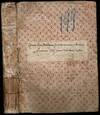1771 · Vicenza
by Baldassare Castiglione (1478-1529)
4 books in 2 volumes: [8]+xvi+255 pages with frontispiece; 205 pages with index and errata. Octavo (8" x 5 3/4) bound in stiff wrappers with labels to spines and deckle edges. This edition not in Bibliotheca Van der Linde-Niemeijeriana; however, there are a number of listings for this title in the bibliography (4315 through 4330), listing 16 editions of various dates and publishers. First published in 1528.
Baldassare Castiglione, count of Novilara was an Italian courtier, diplomat, soldier and a prominent Renaissance author. He was born into an illustrious Lombard family at Casatico, near Mantua. In 1494, at the age of sixteen, Castiglione began (truncated)
Baldassare Castiglione, count of Novilara was an Italian courtier, diplomat, soldier and a prominent Renaissance author. He was born into an illustrious Lombard family at Casatico, near Mantua. In 1494, at the age of sixteen, Castiglione began (truncated)








